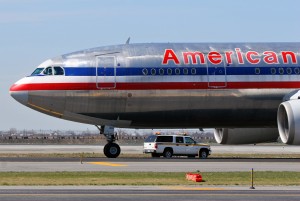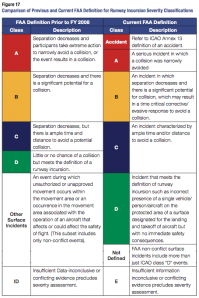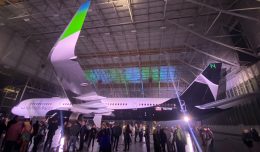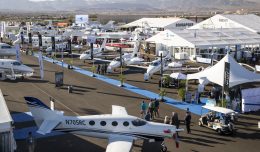James E. Swickard from Aviation Week reported news last week of more progress regarding the Airport Surface Detection Equipment – Model X (ASDE-X) that was rolled out at Newark Liberty (EWR) last Wednesday and went live on the field at Boston’s Logan (BOS) shortly thereafter. James offered a good summary of the technology meant to reduce the incidence of runway incursions and ground collisions, though I must say that I’m not entirely convinced of its effectiveness (that’s not James’ fault).

The "enhanced centerline" and other safeguards on taxiway Z short of runway 31L at JFK. How many safeguards do YOU see here? Leave a comment with your answer, I'll revisit the topic sometime soon. (Photo by Brian Futterman)
The FAA has been installing Sensis Corporation’s ASDE-X [pdf] at airports since 2003 when they started with Milwaukee’s MKE. To date, 19 of the 35 airports scheduled to receive the equipment, have. The system is a sophisticated network of transponders and receivers and computers and – I hope, still – a guy with binoculars in the watchtower. The mission: keep the metal straight, the paint off the ground, money in airlines’ wallets, and passengers’ mouths munching on $2 peanuts instead of on the ears of frustrated flight attendants.
So why am I not completely on-board with ASDE-X? Because it’s only as good as its weakest link, and that’s the transponder.
Let’s go back to the basics for a moment. A runway incursion is the airplane equivalent of running a red light or jaywalking, except you’re liable for your life and the lives of a few dozen or hundred people you’re carrying on your back. And instead of a curb to say “hey, watch out”, pilots reference hold short lines, enhanced taxiway markings, flashing lights embedded in the taxiway and bright location signs at every intersection.
On June 15 at the Paris Air Show, the VP of Product Management for Honeywell said that “one runway incursion happens daily on average worldwide, at a cost to the industry of about $100 million a year“. In instances where a landing airplane is forced to go around because pilots on the ground accidentally taxi onto the active runway, the cost of an incursion can be the cost of going around, whether it be at the discretion of the controller or the pilot. Ground collisions will have their own expenses in the form of aircraft inspections and repairs. Incidents involving only one airplane may not have any monetary cost at all.
I have a hunch that the one-a-day for $100M worldwide estimate is off, and for two reasons:
1. The numbers don’t necessarily work. The FAA’s 2008 Runway Safety Report [pdf] reports, very comprehensively I might add, that there were 1,353 total reported runway incursions from FY2004 through FY2007. Broken down, we get 216 vehicle and pedestrian deviations (overzealous goose shooters, perhaps), 396 operational errors/deviations (ATC foul up, usually by loss of separation), and 741 pilot deviations (over half!). Interestingly, many of the PDs were found to have happened after pilots accurately read back an ATC instruction and then proceeded to do something bad. Like, say, cross a hold short line. With an even and highly-mathematical split we get just over 338 incursions per fiscal year in the United States, which means that we’ve roughly met the one-a-day quota without even crossing a border. I haven’t found a number for international incursions, but I would not be surprised to see our local estimates double or even triple.
2. The phrase itself wasn’t standardized until recently. Until 2007, aviation agencies around the world were using up to 20 different definitions of “runway incursion” with clear disadvantages for those compiling statistics or working towards a solution (or trying to determine frequency). In that year, the International Civil Aviation Organization (ICAO) standardized the phrase with the following definition:
“Any occurrence at an aerodrome involving the incorrect presence of an aircraft, vehicle or person on the protected area of a surface designated for the landing and take-off of aircraft.”
Prior to 2007, the FAA only tagged “potential conflicts” as runway incursions and left the rest – that is, occurrences involving only one airplane – in their separate “surface incidents” file. This might make sense in theory, but in practice, a runway incursion and a surface incident are the same thing with similar causal factors. I’m happy to recognize the international aviation community for their ability to see that if it looks like a runway incursion, and it happens like a runway incursion, it probably is a…
The incentives for change clearly exist; there’s financial motivation, a sense of self-preservation, and pressure to just DO something. Honeywell has acted on all three of these. Alaska Airlines also comes to mind as a runway-incursion-prevention-pioneer.
Where does the transponder come in?
A transponder antenna is roughly the size of your hand. An Airbus A340-600 is 247 feet long. And unless you’re a tree with a cameo in Lord of the Rings, your hand is not. Not by a long shot.
All controllers can see with ground radar is where the transponder is. When they give “Virgin 9 Heavy” from Heathrow clearance to cross runway 22R on its way to the gate, their ground radar display will show the airplane as being clear of the runway when the tail is still over the centerline. During a recent visit to the JFK tower cab, a controller specifically mentioned this as ground radar’s achilles heel, and many other devices around the country are not immune. I think this little tidbit should carry some weight.
In times like this it becomes clear how technology in the National Airspace System is constantly added instead of replaced. En route, knowing the location of the antenna is as good as knowing where the entire airplane is and is adequate for maintaining safe separation, even with pin-point GPS accuracy. But transponders were not specifically designed for the close tolerances necessary in the use of ground radar; instead the opposite is true as ground radar was designed to exploit the transponder.

Does this look like a runway incursion? It's not, but the small antenna on top is similar to the transponder antenna controllers see displayed on ground radar. (Photo by Brian Futterman)
Airport operators are not beyond capitalizing on their facilities, as privatization and landing slots have shown. It would then seem natural for organizations like the Port Authority of New York and New Jersey to further assume this role as a ‘venture capitalist’ and support – thinking out loud here – runway incursion prevention strategies that are truly ground-based (line-of-sight sensors embedded in the taxiway).
To address runway incursions the same way you address airborne traffic separation is like forcing a square peg into a round hole though, to the credit of success that has already been had, the square peg at least has round edges.
Know this: all is not doom and gloom. In terms of innovation, success up until now can be illustrated by FAROS and RWSL. That is, Final Approach Runway Occupancy Signal and Runway Status Lights. Even thought these two projects network with existing ground radar computers to identify collision risks and convey the information to pilots (and are thus reliant on transponders), they make strides towards acknowledging the cause of 54.8% of runway incursions between FY04 and FY07: pilot error. Substantive proof is in the pudding, and the pudding is this June 2009 report by Maria Picardi Kuffner of the MIT Lincoln Laboratory: Human Factors Assessment of Runway Status Lights (RWSL) and Final Approach Runway Occupancy Signal (FAROS) [pdf]. Regarding RWSL, Ed Runyon of Siemens Airfield Solutions says in the excellent YouTube video below that the technology makes for the “first runway safety system that is sensor driven, fully automated, and provides information to the pilots without first going through the air traffic controllers.” Wow. Cue the inappropriate Saturday Night Live music video about things that get you excited…now.
By the way, Siemens is another industry leader often tasked with developing specialized solutions for problems like runway incursions. The system they mention on their website under “Runway Incursion Detection” supports things like RWSL and FAROS and is another strong example of technology that can operate freely and independent of any outside limitations. See their webpage about it here. So far, RWSL and FAROS are only installed at LAX, DFW, and SAN with BOS on the agenda for later this year.
What did the Rabbi say about FAROS? “Let my runway incursion go.” Ha…ha…
Runway incursions have significant implications not only for safety, but also for efficiency and an airline’s bottom line. Accessory to the direct price of an incursion is the time spent dealing with wrong turns, or aborting a takeoff and taxiing back, or going around and returning for another approach. Few airports get as much flak about taxi times and ground delays as the New York City area airports, especially JFK. The logic is simple and sound: one small step for runway incursions could be a giant leap for airport delays.
To that end, I can’t help but think of the ongoing construction projects at JFK, which now total some $500 million over the next several years and are funded mostly by the PANYNJ and the FAA. While they tear up and repave essential taxiways and the arterial 13R/31L, it would be wise to take advantage of the work and install RWSL or FAROS. Or even make Kennedy as a testbed for new inventions (heck, go ahead and generate revenue in a public reverse-X-Prize-esque auction). Maybe the airport could once again become a breeding ground for progress instead of passenger frustration.
Brian Futterman is a long-time contributor to NYCAviation. He is in his senior year in the Department of Aviation Tehcnology at Purdue Univeristy and holds a commercial pilots license with instrument and multi-ratings, as well as his CFI. His blog, Chaos In The Cockpit, features postings dealing with aviation safety and security.








